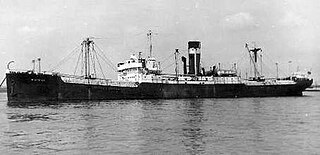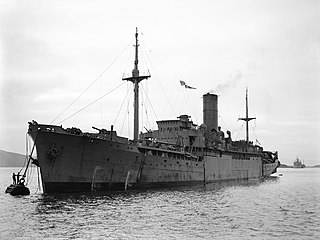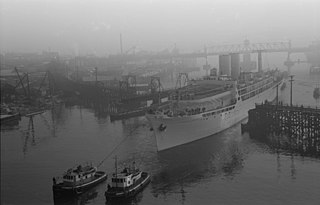
SS Clan Chisholm was a British cargo steamship. She was torpedoed and sunk in the Second World War while carrying cargo from India to Scotland.

SS Blairspey was a steam cargo ship that was built in Scotland in 1929 and served in the Battle of the Atlantic in the Second World War. In 1940 she survived being part of Convoy SC 7 and managed to reach port, despite being hit by at least three torpedoes from two different U-boats. The ship was rebuilt with a new bow and renamed Empire Spey 1942. Her original name was restored in 1946. She was renamed Evandros 1961 and scrapped in Italy in 1967.

SS Corinthic was a British cargo steamship. She was built on Teesside in 1924, sailed in a number of convoys in the Second World War, survived an overwhelming German attack on Convoy SC 7 October 1940, but was sunk by a German U-boat off West Africa in April 1941.

MV Spreewald was a Hamburg America Line (HAPAG) cargo motor ship that was launched in 1922 and sunk in a friendly fire incident in 1942. She was renamed Anubis in 1935, and reverted to her original name Spreewald in 1939.
SS Savoia was a cargo steamship that was built in Italy in 1922. In 1941 the Royal Navy captured her, and the UK Ministry of War Transport renamed her Empire Arun. In 1947 she was sold and renamed Granlake. With further changes of owner she was renamed Dryad in 1949; Shiranesan Maru in 1951; and Dainichi Maru in 1962. The romanised spelling of her name had been revised to Tainichi Maru by 1967. She was scrapped in Japan in 1969.

Clan Alpine was a 7,168 GRT cargo ship which was built in 1942 for the Ministry of War Transport (MoWT) as Empire Barrie. She was sold to Clan Line Steamers Ltd in 1947 and served with them until 1957 when she was sold to Bullard, King & Co Ltd and renamed Umvoti. In 1959 she was sold back to Clan Line and renamed Clan Alpine. She was sold for scrap in 1960 and wrecked in a cyclone in October 1960 at Chittagong, East Pakistan, finally being scrapped in February 1961. She can be seen early on in the 1950 film "Waterfront".
Empire Baxter was a 7,024 GRT cargo ship which was built by Vickers Armstrongs Ltd, Barrow in Furness in 1941. Postwar she served as Paris City, Westford, Severn River and Hüseyin Kaptan before she was scrapped at Haliç, Turkey in June 1963.
Empire Buckler was a 7,046 GRT cargo ship which was built in 1941 by Lithgows Ltd for the Ministry of War Transport (MoWT). Postwar she was sold into merchant service, being renamed Ovingdean Grange, Sabrina, and Noemi, serving until she ran aground in 1965 and was declared a constructive total loss.

SS Polar Chief was a merchant steamship that was built in England in 1897 and scrapped in Scotland in 1952. In her 55-year career she had previously been called Montcalm, RFA Crenella, Crenella, Rey Alfonso, Anglo-Norse and Empire Chief. Early in the First World War she spent eight months pretending to be the battleship HMS Audacious.
MV Wotan was a 5,703 GRT tanker that was built in 1913 by Reiherstieg Schiffswerft & Maschinenfabrik, Hamburg, Germany. Requisitioned by the Imperial German Navy in 1914, she served until 1915 as SMS A and was then returned to her owners. Ceded to the United States in 1919, she was operated until 1920 then laid up following an engine failure.
British Corporal was a 6,972 GRT tanker that was built in 1922 by Palmers Shipbuilding and Iron Company, Jarrow, Northumberland, United Kingdom. She was built for the British Tanker Company.
MV Empire Cross was a motor tanker that was built in England in 1945. She was launched as an Empire ship for the Ministry of War Transport (MoWT). In 1946 she exploded and sank in Haifa in Palestine, killing 25 of her crew.

SS Empire Energy was a cargo steamship. She was built in Germany in 1923 as Grete for small German tramp shipping company. In 1934 the Italian shipping magnate Achille Lauro bought her and renamed her Gabbiano.

SS (RMS) Douglas (III) – the third vessel in the line's history to bear the name – was a packet steamer which entered service with the London and South Western Railway in 1889 under the name Dora until she was purchased by the Isle of Man Steam Packet Company in 1901 for £13,500.
SS Hertford was a refrigerated cargo steamship that was launched in Germany in 1917, seized by the United Kingdom in 1920 as World War I reparations, and sunk by a U-boat in 1942 with the loss of four members of her crew.

HMS Agamemnon was originally the Blue Funnel Line refrigerated cargo ship Agamemnon. She was built in 1929, traded between the United Kingdom and the Far East, and was scrapped in 1963. During the Second World War she was converted into an auxiliary minelayer in 1940, and then into an amenities ship in 1943.

HMS Menestheus was originally the Blue Funnel Line refrigerated cargo ship Menestheus. She was built in 1929, and traded between the UK and the Far East. She was an auxiliary minelayer from 1940 to 1943. In 1945, during the Second World War, she was converted into an amenities ship. She was scrapped in 1953 after being gutted by fire.

SS Pendleton was a Type T2-SE-A1 tanker built in 1942 in Portland, Oregon, United States, for the War Shipping Administration. She was sold in 1948 to National Bulk Carriers, serving until February 1952 when she broke in two in a storm. The T2 tanker ships were prone to splitting in two in cold weather. The ship's sinking and crew rescue is the topic of the 2009 book The Finest Hours: The True Story Behind the US Coast Guard's Most Daring Rescue by Michael J. Tougias and Casey Sherman. The book inspired the 2016 Disney-produced film The Finest Hours with Chris Pine, which focuses on the Pendleton rescue.

SS Gedania was a steam tanker that was launched in Germany in 1919. Until 1939 she imported oil to Germany for the Standard Oil Company of New Jersey. In 1941 the Kriegsmarine had her converted into a supply ship to support commerce raiders at sea. The Royal Navy captured her on her first naval voyage, and the UK Ministry of War Transport renamed her Empire Garden. In 1947 the South Georgia Company bought her; had her converted into a whaling supply ship and whale oil tanker; and renamed her Southern Garden. She was scrapped in Scotland in 1960.

SS Rio Tercero was a cargo steamship that was launched in England in 1912 as Eboe. She was renamed Fortunstella in 1938, and Rio Tercero in 1941. A U-boat sank her in the Battle of the Atlantic in 1942.












